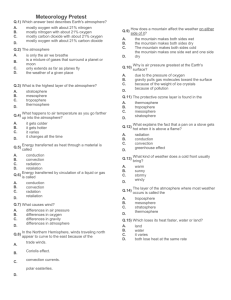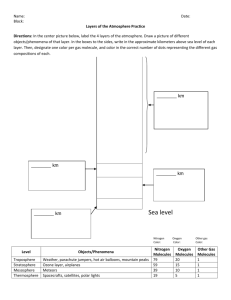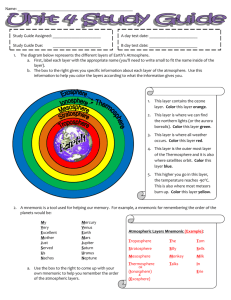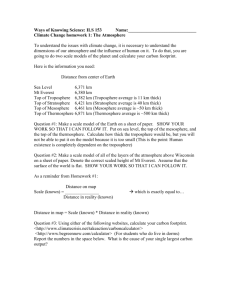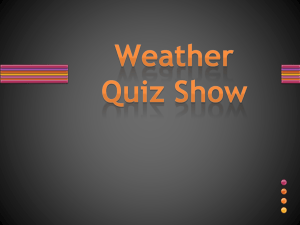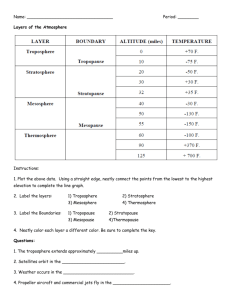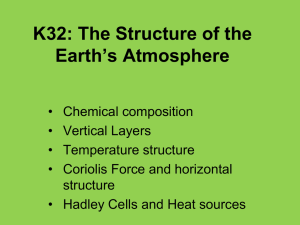Weather Assessment #1
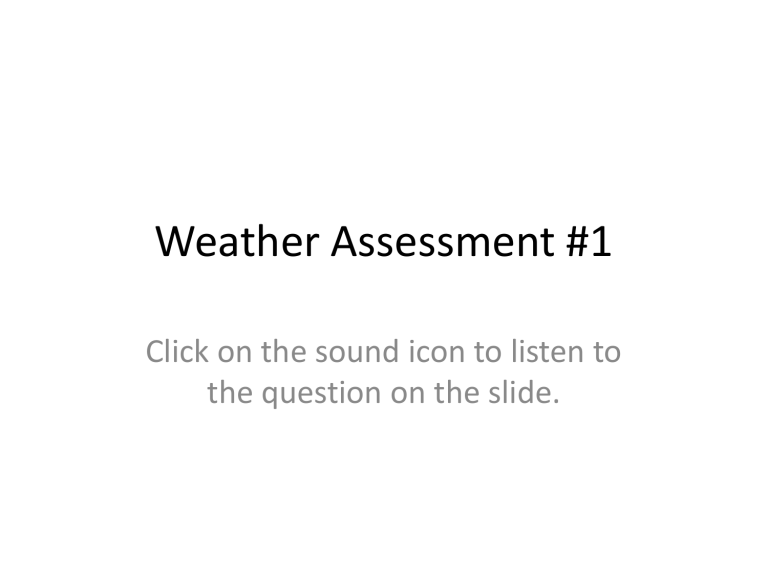
Weather Assessment #1
Click on the sound icon to listen to the question on the slide.
1. The Earth’s atmosphere is approximately
__________ oxygen.
A. 30%
B. 20%
C. 50%
D. 99%
2. Difference in air temperature at different altitudes is mainly caused by:
A. The way air radiates solar energy
B. The way gases radiate light
C. The way gases absorb solar energy
D. The way moisture moves through the atmosphere
3. What are the two highest layers of the atmosphere?
A. Troposphere, Mesosphere
B. Thermosphere, Mesosphere
C. Stratosphere, Thermosphere
D. Troposphere, Stratosphere
4. Auroras are caused by electrically charged particles called:
A. atoms
B. molecules
C. pressures
D. ions
5. Energy transferred as electromagnetic waves through empty space is called:
A. thermal conduction
B. radiation
C. convection
D. Coriolis Effect
6. Energy transferred as heat through a material by direct contact is called
A. thermal conduction
B. radiation
C. convection
D. Coriolis Effect
7. Thermal energy transferred by circulation of a liquid or gas is called
A. thermal conduction
B. radiation
C. convection
D. Coriolis Effect
8. Differences in air pressure cause:
A. wind
B. the Greenhouse Effect
C. Coriolis Effect
D. rotaion of the Earth
9. Air is made up mostly of:
A. oxygen
B. carbon dioxide
C. ozone
D. nitrogen
10.The Earth’s atmosphere is _________ nitrogen.
A. 20%
B. 78%
C. 35%
D. 50%
11. Air pressure is greatest at the Earth’s surface due to:
A. the pressure of oxygen
B. the force of gravity
C. the weight of ice crystals
D. pollution
12. The protective ozone layer is found in the
A. thermosphere
B. mesosphere
C. troposphere
D. stratosphere
13. Most solar energy that reaches Earth’s atmosphere is
A. absorbed by Earth’s surface
B. reflected by Earth’s surface
C. scattered by clouds
D. absorbed by clouds, ozone and gases
14. Wind occurs because air tends to move from regions higher to lower
A. latitude
B. pressure
C. nitrogen levels
D. humidity
15. The type of wind caused by the land being warmer than the ocean during the daytime is:
A. Sea breeze
B. Land breeze
C. Jet stream
D. Coriolis Effect
16. The instrument used to measure air pressure is a:
A. barometer
B. thermometer
C. temperature gauge
D. isobar
Match each item with the correct statement below.
A. Troposphere
B. Thermosphere
C. Stratosphere
D. Mesosphere
17. Ozone is contained in this layer, second layer of the atmosphere
18. Coldest layer, temperature decreases as altitude increases
19. Highest layer of atmosphere; few air particles
20.Densest layer, contains almost 90% of the atmosphere’s mass; closest to Earth
Match each item with the correct statement below.
A. Conduction
B. Convection
C. Radiation
21. Feeling the warmth while standing under a heat lamp
22. Thermal energy transferred by the circulation of a liquid or gas
23. Energy transferred through a material by direct contact
24. Ovens that have a fan to circulate the hot air inside to make it cook faster
25. Cooking a marshmallow over a fire
26. A spoon in a pan getting hotter
27. Rice boiling in a pan
Choose 3 of the following short answer essay questions to answer completely.
28. Based on what you know about the layers of the atmosphere, explain why a helicopter cannot fly into the stratosphere.
29. Using what you have learned about air pressure and temperature, explain why the wind blows toward the land during the daytime (sea breeze). Use a diagram to help explain your answer.
30. Briefly explain the difference between weather and climate.
31. Briefly explain one of the types of heat transfer and give an example.
32. Explain the importance of the ozone layer.
End of Assessment
• Make sure you check over your answers
• Make sure your name is on the assessment paper


